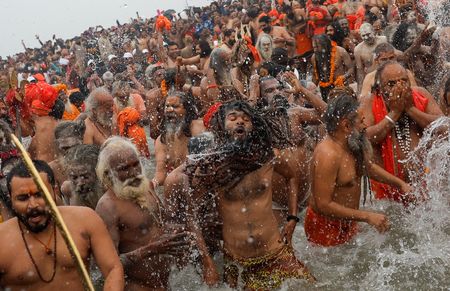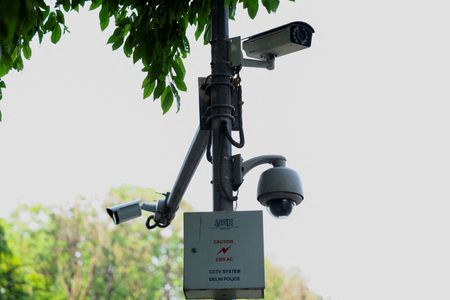By Saurabh Sharma
PRAYAGRAJ, India (Reuters) -Naked Hindu ascetics smeared in holy ash charged into the waters of sacred rivers in India on Tuesday, part of a large crowd of 35 million devotees who took the holy dip on the second day of the Maha Kumbh Mela, or Great Pitcher Festival, seeking absolution from their sins.
The “royal bath” of the ascetics is a key part of the event, held every 12 years in the northern city of Prayagraj, because Hindus believe it confers salvation from the cycle of birth and death, in addition to the absolution of sins.
Thousands of devotees watched the ascetics take a dip in freezing waters, dreadlocks flying and clad only in holy beads, though some carried tridents, spears, or maces, after a procession to the water accompanied by chants and the beat of drums.
“The crowd today was fantastic,” said ascetic Rakesh Kumar after his holy dip at the confluence of the rivers Ganga, Yamuna, and the mythical Saraswati. “We need people to follow our faith and participate in festivals like this.”
On Tuesday, 35 million people “earned the holy benefit” of taking a dip, Uttar Pradesh State Chief Minister Yogi Adityanath said, thanking authorities for their efforts to maintain law and order.
Nearly 15 million people, more than double the 6 million population of the city, had taken a ritual dip on Monday, when the six-week festival, expected to attract more than 400 million people, began.
The Kumbh originates in a Hindu belief that four drops of the nectar of immortality fell to earth, one in Prayagraj, during a battle between the god Vishnu, known as the Preserver, and demons over a golden pitcher holding the elixir.
Every 12 years, the festival is described as “maha” or great, as the timing is considered to render it more auspicious, drawing bigger crowds.
More than 150,000 tents have been set up across 4,000 hectares (9,900 acres), or the size of 7,500 football fields, to accommodate visitors, and nearly as many toilets.
About 50,000 security officers are also on guard to ensure the event, touted to be the world’s largest gathering of humanity, goes off smoothly.
In the past, the gathering has been visible from space, with India’s space agency releasing photographs of it in 2019.
The budget for this year’s festival is an estimated $800 million and analysts estimate it will boost economic growth by $30 billion to $35 billion.
(Additional reporting by Tanvi Mehta in New Delhi; Writing by Sakshi Dayal; Editing by YP Rajesh, Clarence Fernandez and Hugh Lawson)














